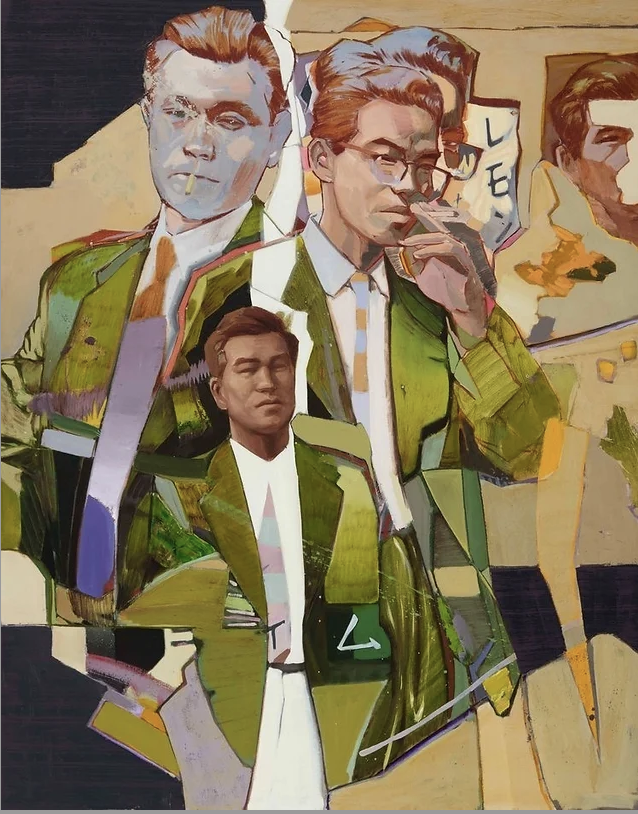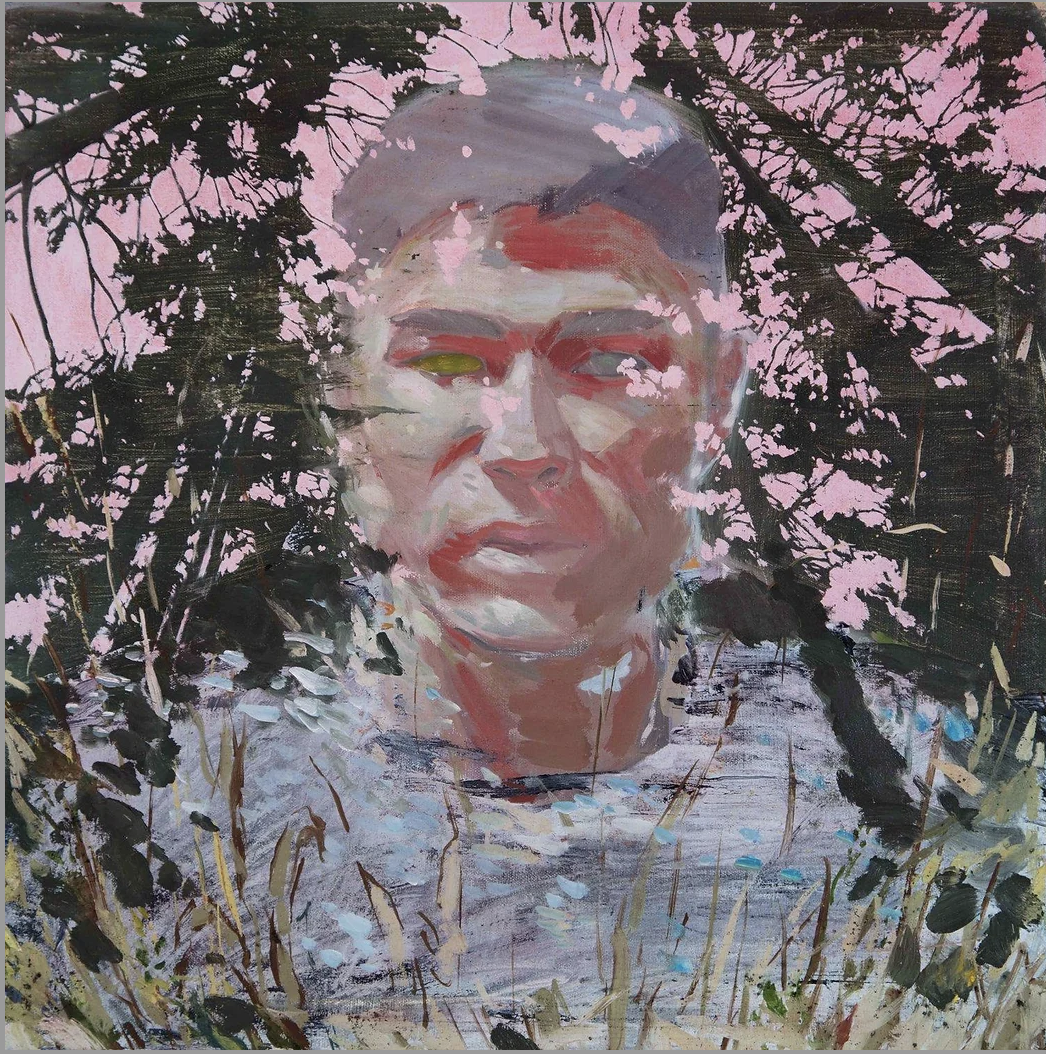SHANE KEISUKE BERKERY
Shane Keisuke Berkery is an Irish-Japanese contemporary artist based in Dublin, Ireland. His cultural background has been a major influence on his work and is a frequent theme in his paintings. Berkery graduated from the National College of Arts and Design in Dublin, Ireland. He is a recipient of Hennessy Craig Scholarship at the RHA annual exhibition and a winner of the National University of Ireland Art and Design Prize (2015). Berkery primarily works out of his studio in Dublin.

The following is a condensed version of a conversation that happened between Grey State and Shane Berkery on October 21st 2022. Edited for clarity.
Grey State (GS): Can
you tell me about your initial encounter with art: how did it speak to you, how did it call to you, and how did you come to make art?
Shane Berkery (SB): It's kind of like the same old story: I always drew as a kid. My mom studied architecture, and she'd bring me into the studio sometimes. And while she was working, she'd give me some scraps to play around with and I'd be drawing or making these little nonsensical sculptures. When I was younger, I thought I wanted to be a Japanese manga artist. Throughout school I kept up with drawing. For this universal exam that everyone takes, I got enough points to get into medicinal chemistry, but I also put in a portfolio for an art college and I also got in there. At that point, my mom was like: “well, I think you're better suited for art. You've always loved it.” And so I decided to go to art college.”
Grey State (GS): Can
you tell me about your initial encounter with art: how did it speak to you, how did it call to you, and how did you come to make art?
Shane Berkery (SB): It's kind of like the same old story: I always drew as a kid. My mom studied architecture, and she'd bring me into the studio sometimes. And while she was working, she'd give me some scraps to play around with and I'd be drawing or making these little nonsensical sculptures. When I was younger, I thought I wanted to be a Japanese manga artist. Throughout school I kept up with drawing. For this universal exam that everyone takes, I got enough points to get into medicinal chemistry, but I also put in a portfolio for an art college and I also got in there. At that point, my mom was like: “well, I think you're better suited for art. You've always loved it.” And so I decided to go to art college.”


GS: Why is it that you chose painting? Have you ever considered working sculpturally?
SB: The painting department at my college was the most open and it was also most suited to what I had been doing until then. I was considering going into sculpture, but what deterred me from that was that the sculpture course was incredibly conceptual, it was a lot more about the backup text. I haven't actually done any sculpture in the last six or seven years, but I keep thinking about getting some clay and doing something.
GS: Something I remember you mentioning in our previous conversation is that with each painting you're really trying to experiment and create something new. This is very interesting to me: as an artist who has such a high level of technical skill, it would be so easy to just stick to one style and then profit off of it. Could you expand a little bit on your approach to painting?
SB: I think a big part of it stems from my experiences of going into other galleries and noticing that artists often find their thing, and then that's the thing that they do. I'm not saying all the artists, but a lot of artists are thinking: “Okay, the style works, it's selling well, I like it. I'm gonna paint more of this so that the collectors know my work and my style.” You just don't see much growth in this approach. In response to that, I myself like to see a variety when I go to see an exhibition. And then also, I like to imagine that I'm always getting better. I think that's the thing that I'm trying to work towards. I'm just always consciously trying to improve. For example: the skill to do realistic rendering, to me, is an important skill to have so I'm always working on that in one way or another. Other than that, it's color, and composition, and a general way in which something is painted. Just kind of working out all the muscles, trying to not get stagnant.

GS: You mentioned how good it feels to grow professionally and artistically; do you ever feel like you're going downhill instead of uphill? If so, even if they're very brief moments, how do you deal with those feelings?
SB: I'm telling my girlfriend sometimes that I feel like I'm getting worse. 2021 was a slow year in terms of my productivity and avenues to show; I was kind of feeling a “writer's block” of sorts: I wasn’t feeling creatively inspired. One thing I tried was hypnosis, which actually helped a lot. Negative self-talk was a big part of that kind of block for me, so he [the hypnotist] basically told me to just force myself to repeat a positive phrase over and over again in my head, something like “I am enough.” Eventually, your thoughts turn into beliefs. One other thing: attending exhibitions, socializing with other artists gets me more motivated to work. When you're unproductive, you feel like It's harder to create. I was forcing myself to do stuff and not be too critical about it: I started doing some paintings just for fun, silly things. Such an amalgamation of things really helps me with motivation.
GS: In this moment when you have these negative thoughts, you still have a lot of external validation through collectors and generally a good deal of professional success. I'm wondering if that impacts the way that you talk to yourself and if that is a way that can help you get out of negative loop.
SB: Oh, I do go back and appreciate the fact that I'm able to do all that. But when you're in that kind of mindset of negative self-talk, you often forget about that. For me, it feels more about the painting itself, a frustration of it not going well: when you look at the painting and at that moment it looks to you worse than something you’ve done before. But I do try to be a bit more objective.
GS: Sometimes, it seems to me that in this chase to become better people forget how much you're supposed to enjoy making art, right? I think that one could describe your work as “playful”: you often combine meticulously painted figuration with abstract elements that are much more loose in nature. I find this to be a very attractive quality in your work. I hope you have a show in New York sometime!
SB: Oh that would be great. I'm working on some things to hopefully make into a portfolio to kind of try to convince some galleries to have a show with me. Maybe New York? We'll see how it goes.
GS: Jack Nicholson portraits? Well, if that doesn't work out, you can always do pet portraits.
SB: Yeah, actually, my dad made me set up a pet portrait website while I was in college; he also said that would be a good business idea. It never took off.
GS: Is there some remnant of that somewhere kicking around on the Internet?
SB: The website was drawmypet.com, but it might have gone to the next person by now.
GS: We also wanted to talk to you about social media. I came across your Instagram page at what now feels like the dawn of time (2013?). It never felt like you took Instagram too seriously; it felt fun. How do you navigate that relationship? What do you think of social media platforms right now with how important they’ve become for artists?
SB: I don't take myself seriously at all on Instagram. I think it was a positive place there for a while when it felt like a place where everyone just posts their pictures and artists can show their work and get a following from people that like seeing their stuff. It still is an important way to have your work seen and maybe is almost necessary these days and it definitely has brought me opportunities I would not have had otherwise, like this show with you guys!
GS: Who are the artists you look up to?
SB: Um, I like, There's an artist called Freidrech Einhoff — I really love his paintings — Marlene Dumas. My favorite painter is well, kind of cliche, but Francis Bacon. Who else? I always forget them when I get asked. I was at a Cecily Brown exhibition in Berlin recently and really like her work as well.


GS: Coming back to Instagram: there's often a certain persona that people develop on Instagram; I think yours is, perhaps, a little bit more ironic at points. Is there a juxtaposition between the social-media Shane and Shane in the professional art space?
SB: I've kind of gotten much better at talking about my art over time, but even then, in person, I don't take it too seriously. There's not much pressure for me to be serious.
GS: Earlier in our conversation you said “back in Japan” and I would like to come back to that for a moment. You were born in Tokyo, right?
SB: Yes, I was born in Tokyo, then moved to America when I was one and then went back to Japan when I was seven, and then moved to Ireland when I was fourteen.
GS: Considering how frequently you moved early on in your life, what does home mean to you? And what does belonging entail?
SB: Dublin feels like home to me now. What does it mean? I think the question of belonging was more relevant when I was In America and Japan. Or when I first moved here. Yeah, then the question of belonging was something more on my head and something that I got upset about. In Japan, it was a very homogeneous society. I was the only foreigner in the village and in the school. Even though I'm half Japanese, half Irish, the people there thought of me as white. And then, in school over here in Ireland—even now I guess—I'm seen as just Asian rather than anything else. I think people tend to see the parts that are different about you. When I was younger, that was something that bothered me. After school though, when everyone's grown up, I don't know … I feel completely accepted here. I feel like this is my home and I love it.
GS: This kind of works for somebody who's dealt with multiple identities before: you have mountains here, you have the beach there, and you have the history over there. It's also interesting how your painting seems to be mirroring the city: you combine a lot of contemporary elements with tradition, too.
SB: Yeah, maybe that's where it comes from.

GS: Let’s imagine that you, being fourteen or fifteen, saw your work now. What could it do for a young Shane? What impact would it have on you?
SB: If I were to see the stuff that I'm doing now back then, I think it would give me a different perspective, you know? It would show me how to embrace the bits I have and treasure this mixture of things I have in me. That could have definitely helped a small me.
GS: I got an impression that you faced social stigma as a result of your multi-ethnic identity. Do you think it posed more concrete barriers, especially when entering an artistic career?
SB: To be honest, I think a big part of the fact that my degree show went so well was because I was doing these Japanese things, so I think it's kind of the opposite in a way. Now is a good time for someone like me because the world is opening up in a lot of ways. In my case, it worked to my professional advantage that I was perceived as a bit “exotic” in Ireland. I also wanted to point out that I wasn't ostracized as such. When I was in Japan, I made friends quickly enough and was happy there. Yeah, I wouldn't say I was ostracized and I don't want to sound like a sob story. I guess at that age I just wanted to be like all the other kids, and it was a bit difficult at times when you were being treated as if you're different. Same when I first came here, in school it felt like it was repeatedly brought to my attention that I was Japanese, which wasn’t a nice feeling. Having grown up it’s turned around and I’m happy and grateful for the way I am.
